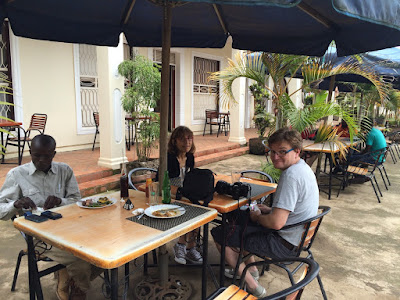Chimps Habituation Experience
I recently led a safari to Kibale Forest for Chimps tracking. This is one of the trips i usually organise an remains one of my favourite. Myself and guest set out from Kampala in the morning, driving through a stunning countryside, dominated by beautiful landscapes and farmlands. It took us about 6 hours to Fortportal where we had lunch, before proceeding to Kibale forest. I had booked for a whole day habituation experience with eh chimps. This is the only way to to maximise photographic opportunities.
Kibale’s most popular activity is the Kanyanchu Primate Walk. Thirteen species can be sought, and a good variety of diurnal monkeys invariably encountered, but the stars of this trail are the chimpanzees. Kanyanchu’s chimps have been tracked since 1993 and the chances of locating them are excellent. Guided walks start at 8am and 2pm and last an average of three hours, depending on various factors.
Kibale’s most popular activity is the Kanyanchu Primate Walk. Thirteen species can be sought, and a good variety of diurnal monkeys invariably encountered, but the stars of this trail are the chimpanzees. Kanyanchu’s chimps have been tracked since 1993 and the chances of locating them are excellent. Guided walks start at 8am and 2pm and last an average of three hours, depending on various factors.
The full-day Chimpanzee Habituation Experience (CHEX) works with a chimp community which is undergoing habituation. Early visitors can watch chimps leaving their overnight nests between 6:00 - 6:30am before feeding, copulating, hunting, breastfeeding, resting, patrolling and displaying until it is time to build new nests around 7pm.
Kibale national park
Kibale National Park contains one of
the loveliest and most varied tracts of tropical forest in Uganda. Forest
cover, interspersed with patches of grassland and swamp, dominates the northern
and central parts of the park on an elevated plateau.
The park is home to a total of 70 mammal species, most famously 13 species of primate including the chimpanzee. It also contains over 375 species of birds. Kibale adjoins
Queen Elizabeth National Park to the south to create a 180km-long corridor for
wildlife between Ishasha, the remote southern sector of Queen Elizabeth
National Park, and Sebitoli in the north of Kibale National Park.
The Kibale-Fort Portal area is one
of Uganda’s most rewarding destinations to explore. The park lies close to the
tranquil Ndali-Kasenda crater area and within half a day’s drive of the Queen
Elizabeth, Rwenzori Mountains and Semliki National Parks, as well as the
Toro-Semliki Wildlife Reserve.
Geography and
climate
Kibale National Park is located in
the districts of Kabarole and Kamwenge, approximately 320 kilometres, by road,
west of Kampala, Uganda's capital and largest city. Fort Portal in Kabarole
District is the nearest large city to the national park and this is where you can ideal stop for lunch before proceeding to Kibale. The geology consists
of rocks formed in the Precambrian period which are sedentary, strongly folded
and metamorphosed. The Toro system overlaying these rocks forms prominent
ridges of quartzite and sometimes schists and phyllites, which are intruded by
amphibiolites, gneiss and granites. Some hills have layers of hard laterite
exposed on them. About 90% of the Park is overlain by red ferralitic soils of
which 70% are sandy clay loams in the North and 30% are clay loams in the
South. These soils are deeply weathered, show little differentiation in horizon
and are of very low to moderate fertility. The remaining 10% is where fertile
eutrophic soil occurs on a base of volcanic ash limited to Mpokya and Isunga
areas on the western edge of the park.
The park has a tropical type of
climate with two rainy periods, March to May and September to November. The
annual mean temperature range rises from 14° - 15°C, - minimum to 26° - 27°C
maximum. The annual rainfall is 1,100 - 1,600 mm. There is a pronounced dry
season in December to February. Rain falls more in the North than in the South.
The tea country to the north of the forest is a great scenery to welcome you
Garden Restaurant at Fort Portal
is a good place to stop over for lunch if you are driving in from Kampala
A view of the restaurant from the car park
A nice welcome for us by a local dancers at our lodge (Primate lodge)
We left very early in the morning to look for the Chimps
Mr. Silver, was our guide. He is superb an knows the area intimately. He has worked here for 24yrs
In the forest we kept our selves busy looking around as we followed the Chimps
2
1
3
4
Mr. Silver looks up in the trees for the Chimps
5
One of the moths found in the forest
6
7
8
9
10
11
12
12
13
Resting during the down time
One time we followed the Chimps into neighbouring farm
As it is a long day exercise, it can be tiresome, so a rest is necessary
In the afternoon, we were caught up in the rain
Ensure you have proper rain gear
Makeshift canopy
A walk home at the end of the exercise




















































1 comment:
Funny, happy and unforgettable memories !
Post a Comment